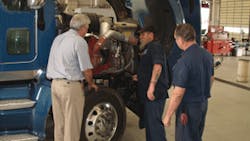Leadership plays an essential role in the efficiency, productivity and profitability of any maintenance shop. When done effectively, leaders establish direction and then influence and align their “human capital” (workforce) toward a common goal, motivating and committing them to action and making them accountable and responsible for their performance.
It was President Dwight Eisenhower who said: “Leadership is the art of getting someone else to do something you want done because he wants to do it.” Author Paul J. Meyer noted: “Productivity is never an accident. It is always the result of a commitment to excellence, intelligent planning and focused effort.”
Leadership in the shop is taking on even greater significance as the pace of change to vehicles and components and their maintenance and service continues to increase. Development of leadership abilities and skills is an integral element of the curriculum of the NAFA Fleet Management Association’s Certified Automotive Fleet Manager (CAFM) Program. It is the oldest and largest fleet certification in the world and is the only program that attests to one’s expertise in the profession.
NAFA is a not-for-profit, individual membership professional society that serves the needs of members who manage fleets of all types of vehicles and mobile equipment for organizations across the globe.
According to the CAFM Program materials, at the heart of good leadership is effective communications. Many of the problems that occur in an organization are the direct result of people failing to communicate. “Faulty communication leads to confusion and can cause a good plan to fail,” says Phillip E. Russo, NAFA’s executive director who oversees the administration of the CAFM Program. “Effective communication occurs only if the receiver understands the exact information or idea that the sender intended to transmit.”
This is not as easy or as simple as it sounds as there are many barriers to communicating effectively. These include culture, background and bias; a lack of concentration or distractions; preconceived attitudes; and stress.
These barriers can be thought of as filters which muffle the message, Russo says. Citing materials from the NAFA CAFM Program, he says the message leaves the sender, goes through the aforementioned filters and is then heard by the receiver. The way to overcome filters is through active listening and feedback.
ACTIVE LISTENING
Hearing and listening are not the same thing. Hearing is the involuntary act of perceiving sound through the ear. Listening is a selective activity involving receiving and analyzing what is heard.
Listening is divided into two main categories: passive and active. Passive listening is little more than hearing. It occurs when the receiver of the message has little motivation to listen carefully, such as music, television or being polite. Active listening is listening with a purpose - to gain information, obtain directions, understand others, solve problems, etc.
The purpose of feedback, explains Russo, is to change and alter messages so the intention of the original communicator is understood by the person receiving the communication. Providing feedback is accomplished by paraphrasing the words of the sender and restating the sender’s feelings or ideas in one’s own words.
The NAFA CAFM Program advises speaking with “comfortable words” - those that are easily understood, and when trying to explain involved or complicated matters, asking the listeners if they understand. Also, it says to be sure to give the receiver a chance to comment or ask questions.
“Try to put yourself in the other person’s shoes and consider the feelings of the receiver,” Russo advises. “Be clear about what you say. Look at the receiver. Make sure your words match your tone and body language. Vary your tone and pace. Do not be vague, but on the other hand, do not complicate what you are saying with too much detail. Do not ignore signs of confusion.”
HUMAN RELATIONS
Effective leaders are made, not born. They learn from trial and error and from experience.
As was mentioned previously, leadership is a process by which a person influences others to accomplish an objective and directs the organization in a way that makes it more cohesive and coherent. Leaders carry out this process by applying their leadership attributes, such as beliefs, values, ethics, character, knowledge and skills, says Russo. Just being in a position of authority and power does not make a person a leader, but rather, simply makes them a boss.
The NAFA CAFM Program teaches that there are 11 principles of leadership:
Know yourself and seek self-improvement. - Understand your attributes and work on continually strengthening them.
Be technically proficient. - Know your job and have a solid familiarity with your employees’ tasks.
Seek responsibility and take responsibility for your actions. - Search for ways to guide your organization to new heights. When things go wrong, and they always do sooner or later, don’t blame others. Analyze the situation, take corrective action and move on to the next challenge.
Make sound and timely decisions. - Use good problem solving, decision making and planning tools.
Set the example. - Be a good role model for your employees. They must not only hear what they are expected to do, but also see.
Know your people and look out for their well-being. - Know human nature and the importance of sincerely caring for your workers.
Keep your workers informed. - Know how to communicate with not only them, but also seniors and other key people.
Develop a sense of responsibility in your workers. - Help to develop good character traits that will help them carry out their professional responsibilities.
Ensure that tasks are understood, supervised and accomplished. - Communication is the key to this responsibility.
Train as a team. - Although many so called leaders call their organization, department, section, etc., a team, they are not really teams but rather just a group of people doing their jobs.
Use the full capabilities of your organization. - By developing a team spirit, you will be able to employ your organization, department, section, etc., to its fullest capabilities.
CHANGE MANAGEMENT
At some time or another, all leaders must deal with change. In today’s highly competitive business world, change must be quickly dealt with. Good leaders help make change smooth and as painless as possible by making others want to be part of it. No easy task, as the typical reaction to change is to resist it.
“People get comfortable performing tasks and processes a certain way,” Russo says. “This comfort provides them with the security that they are the masters of their environment. They fear that change could disrupt their lives by making them look like a fool by not being able to adapt and learn, making their jobs harder, loosing a sense of control, etc.”
Leaders can help the change process by changing their employees’ attitude from avoidance into acceptance, the NAFA CAFM Program instructs. This is accomplished by changing employees’ avoidance questions and statements into acceptance questions:
From “Why?” to “What new opportunities will this provide?” When workers ask “why,” focus on the benefits that the change will provide them and the organization. “Do not feel uncomfortable if you are feeling hesitation about the change too,” Russo offers. “You are also human. By spelling out the benefits, you will not only comfort them, but help to convince yourself too.”
From “How will this affect me?” to “What problems will this solve?” Anything that prevents something from being better is a problem. Let workers know what the problem is and how they will be part of the solution.
From “We don’t do it this way” to “What would it look like?” One of a worker’s first reactions often is: It has never been done this way or it cannot be done this way. “Show them, provide plenty of explanations and compassion, and get your team to ask and answer questions,” says Russo.
From “When will this change be over so we can get back to work?” to “What can I do to help?” Get workers involved in implementing the change and help them to become part of it.
From “Who is doing this to us?” to “Who can help us?” Focus on the challenges that must be overcome. “Ensure that you enlist help from other departments and colleagues,” he says.
UNCOMPROMISED VALUES
Ethical behavior is a trait common to all good leaders. They exhibit both their values and their ethics in their leadership style and actions, helping to prevent a lack of trust - a problem in many workplaces. If leaders never identified their values in these workplaces, the mistrust is understandable. People don’t know what they can expect.
If an organization’s leadership has a code of conduct and ethical expectations, they are meaningless unless the leaders live up to the published code. Leaders that exhibit ethical behavior powerfully influence the actions of others.
According to the NAFA CAFM Program, there are four basic components of ethical leadership that must be understood and developed:
Purpose - The ethical leader reasons and acts with organizational purposes firmly in mind. This provides focus and consistency.
Knowledge - The ethical leader has the knowledge to judge and act prudently. This knowledge is found throughout the organization and its environment, but must be shared by those who hold it.
Authority - The ethical leader has the power to make decisions and act, but also recognizes that all those involved and affected must have the authority to contribute what they have toward shared purposes.
Trust - The ethical leader inspires - and is the beneficiary of - trust throughout the organization and its environment. Without trust and knowledge, people are afraid to exercise their authority.
These elements are interrelated components, the CAFM Program points out. Attention to any one component alone is incomplete and misleading.
Russo, explaining the NAFA CAFM materials, says being an ethical leader means applying the right amount of authority in each situation, and notes that it is helpful to exercise authority within five modes of intervention into the judgments and actions of other. These levels are:
Inspiration - Setting the example so that other committed members will contribute their fullest capabilities to achieve organizational purposes. (The lowest degree of intervention.)
Facilitation - Supporting other committed members and guiding them where necessary so that they are able to contribute their capabilities as fully as possible.
Persuasion - Appealing to reason to convince other members to contribute toward achieving organizational purposes.
Manipulation - Offering incentives other than the intrinsic value of contributing to the achievement of organizational purposes, where commitment is lacking.
Coercion - Forcing other members to contribute some degree of their capability where they have little or no commitment to do so on their own. (The highest degree of intervention.)
KEY COMPETENCIES
Studies show that some 80 percent of problems experienced in any organization are people-related, so good leadership is a great benefit. With good leadership in a maintenance organization, workers feel they are valued and an integral part of the development of the organization.
This invariably results in a stronger business, which is good for your operation’s bottom line.
The necessary characteristics foundational to good leadership can be cultivated, developed and strengthened, provided you are willing to invest the time. It is well worth the effort, concludes Russo, because effective leaders steer their workforce to achieve all the critical aspects of their company’s goals and objectives, and to the success of individuals within the workforce.
About the Author

